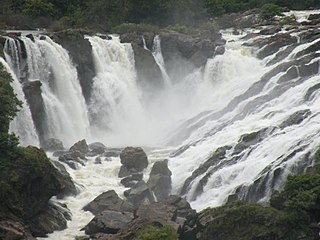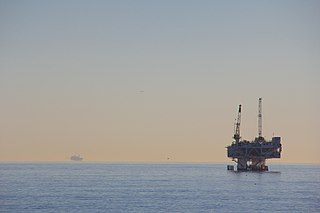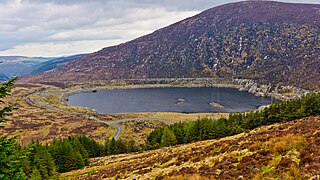Spirit of Ireland is a proposal to build pumped-storage hydroelectricity reservoirs in valleys in Ireland's west coast combined with large-scale on-shore and off-shore windfarms to reduce Ireland's dependence on imported energy and fossil fuels. It would initially involve identifying up to five coastal valleys from counties Donegal to Cork, building dams on their seaward side and flooding them with sea water. These would provide a hydro-power back-up for the wind farms. The proposal has been likened to the construction of the Ardnacrusha hydroelectric power scheme, which was Ireland's first large post-independence infrastructure project and required investment equivalent to 25% of the national budget at the time but met the majority of the state's electricity needs for 50 years. [1]
The project came about when the two founders of the Pumped Hydro Electric Company (Dermot McDonald and Mark Wheeler) met Igor Shvets, a physics professor at Trinity College Dublin and Graham O'Donnell. McDonnell and Wheeler were promoting large scale seawater Pumped Storage as a solution to some of Ireland's electricity balancing and storage issues while Shvets was proposing energy independence for Ireland in his 2008 talk entitled The Energy Options for Ireland. [2] [3] Following the talk local engineers, scientists and businesspeople including Orbiscom co-founder Graham O'Donnell formed a foundation to further study the idea. [4]
Typically, wind farms only produce 25 to 35 per cent of their maximum possible electricity output when measured over a long period. The proposed hydro-generating stations would come into play when wind speeds were either too low or too high to be useful. Each of the reservoirs would be able store up to 100 gigawatt-hours of hydro energy.
Under the Spirit of Ireland proposals, a very typical natural valley water reservoir would have a dammed lake area when full of 4 square Km – e.g. average 2 km x 2 km. Based on studied shapes, depths and height from the sea etc., two such reservoirs would deliver some 200 GWh of electrical energy. A third reservoir would increase this to 300 GWh. This is a considerable energy store and in fact there are many valleys studied which would give considerably larger storage. 30 potential locations have been considered by engineers involved in the project. [5]
The long-term strategy is to develop higher capacity electrical interconnectors with continental Europe which would allow export of excess generating capacity whilst allowing for the import of electricity in the event of sustained no wind conditions. This scenario would be expected to be very infrequent and during such times the reservoirs would be filled using imported electricity at off peak times which would command much lower prices. Locations for the pumped storage reservoirs have not yet been decided but are expected to be located in areas that are otherwise economically deprived which would help to fulfil the Irish goal of balanced regional development. [6]
In 2013, Statoil was approached as part of a €1.5bn first round funding drive for the project, but declined to participate. The scheme has failed to find further investors and several of the engineers involved have halted design work on the project until investment can be found. [7] Additional electrical interconnector projects like the Celtic Interconnector between Ireland and France are progressing with Irish government funding and European Investment Bank support, these high capacity interconnectors with the rest of the European supergrid may make the project more viable in the future.

Pumped-storage hydroelectricity (PSH), or pumped hydroelectric energy storage (PHES), is a type of hydroelectric energy storage used by electric power systems for load balancing. The method stores energy in the form of gravitational potential energy of water, pumped from a lower elevation reservoir to a higher elevation. Low-cost surplus off-peak electric power is typically used to run the pumps. During periods of high electrical demand, the stored water is released through turbines to produce electric power. Although the losses of the pumping process make the plant a net consumer of energy overall, the system increases revenue by selling more electricity during periods of peak demand, when electricity prices are highest. If the upper lake collects significant rainfall or is fed by a river then the plant may be a net energy producer in the manner of a traditional hydroelectric plant.

Hydroelectricity, or hydroelectric power, is electricity generated from hydropower. Hydropower supplies one sixth of the world's electricity, almost 4500 TWh in 2020, which is more than all other renewable sources combined and also more than nuclear power. Hydropower can provide large amounts of low-carbon electricity on demand, making it a key element for creating secure and clean electricity supply systems. A hydroelectric power station that has a dam and reservoir is a flexible source, since the amount of electricity produced can be increased or decreased in seconds or minutes in response to varying electricity demand. Once a hydroelectric complex is constructed, it produces no direct waste, and almost always emits considerably less greenhouse gas than fossil fuel-powered energy plants. However, when constructed in lowland rainforest areas, where part of the forest is inundated, substantial amounts of greenhouse gases may be emitted.

The Dinorwig Power Station, known locally as Electric Mountain, or Mynydd Gwefru, is a pumped-storage hydroelectric scheme, near Dinorwig, Llanberis in Snowdonia national park in Gwynedd, north Wales. The scheme can supply a maximum power of 1,728 MW (2,317,000 hp) and has a storage capacity of around 9.1 GWh (33 TJ).

The Electricity Supply Board is a state owned electricity company operating in the Republic of Ireland. While historically a monopoly, the ESB now operates as a commercial semi-state concern in a "liberalised" and competitive market. It is a statutory corporation whose members are appointed by the government of Ireland.

India is the third largest producer of electricity in the world. During the fiscal year (FY) 2022–23, the total electricity generation in the country was 1,844 TWh, of which 1,618 TWh was generated by utilities.

Grid energy storage is a collection of methods used for energy storage on a large scale within an electrical power grid. Electrical energy is stored during times when electricity is plentiful and inexpensive or when demand is low, and later returned to the grid when demand is high, and electricity prices tend to be higher.

Hybrid power are combinations between different technologies to produce power.
The electricity sectors of the Republic of Ireland and Northern Ireland are integrated and supply 2.5 million customers from a combination of coal, peat, natural gas, wind and hydropower. In 2022, 34 TWh were generated. In 2018 natural gas produced 51.8%, while wind turbines generated 28.1%, coal 7%, and peat 6.8% of Ireland's average electricity demand. In 2020 wind turbines generated 36.3% of Ireland's electrical demand, one of the highest wind power proportions in the world. While the United Kingdom was one of the first countries in the world to deploy commercial nuclear power plants, the island of Ireland has never had a nuclear power plant built on either side of the Irish border. Nuclear power in Ireland was discussed in the 1960s and 1970s but ultimately never phased in, with legislation now in place explicitly forbidding its introduction.

India is 5th globally for installed hydroelectric power capacity. As of 31 March 2020, India's installed utility-scale hydroelectric capacity was 46,000 MW, or 12.3% of its total utility power generation capacity. Additional smaller hydroelectric power units with a total capacity of 4,683 MW have been installed. India's hydroelectric power potential is estimated at 148,700 MW at 60% load factor. In the fiscal year 2019–20, the total hydroelectric power generated in India was 156 TWh with an average capacity factor of 38.71%.

Energy in Malta describes energy production, consumption and import in Malta. Malta has no domestic resource of fossil fuels and no gas distribution network, and relies overwhelmingly on imports of fossil fuels and electricity to cover its energy needs. Since 2015, the Malta–Sicily interconnector allows Malta to be connected to the European power grid and import a significant share of its electricity.

The electricity sector in Iceland is 99.98% reliant on renewable energy: hydro power, geothermal energy and wind energy.

The electricity sector in Switzerland relies mainly on hydroelectricity, since the Alps cover almost two-thirds of the country's land mass, providing many large mountain lakes and artificial reservoirs suited for hydro power. In addition, the water masses drained from the Swiss Alps are intensively used by run-of-the-river hydroelectricity (ROR). With 9,052 kWh per person in 2008, the country's electricity consumption is relatively high and was 22% above the European Union's average.

Ireland is a net energy importer. Ireland's import dependency decreased to 85% in 2014. The cost of all energy imports to Ireland was approximately €5.7 billion, down from €6.5 billion (revised) in 2013 due mainly to falling oil and, to a lesser extent, gas import prices. Consumption of all fuels fell in 2014 with the exception of peat, renewables and non-renewable wastes.

As of 2018, hydroelectric power stations in the United Kingdom accounted for 1.87 GW of installed electrical generating capacity, being 2.2% of the UK's total generating capacity and 4.2% of UK's renewable energy generating capacity. This includes four conventional hydroelectric power stations and run-of-river schemes for which annual electricity production is approximately 5,000 GWh, being about 1.3% of the UK's total electricity production. There are also four pumped-storage hydroelectric power stations providing a further 2.8 GW of installed electrical generating capacity, and contributing up to 4,075 GWh of peak demand electricity annually.

Energy in California is a major area of the economy of California. California is the state with the largest population and the largest economy in the United States. It is second in energy consumption after Texas. As of 2018, per capita consumption was the fourth-lowest in the United States partially because of the mild climate and energy efficiency programs.

The electricity sector of Kosovo relies on coal-fired power plants and is considered one of the sectors with the greatest potential of development. The inherited issues after the war in Kosovo and the transition period have had an immense effect on the progress of this sector.

The Turlough Hill Power Station is a pumped storage power station in Ireland, owned and operated by the Electricity Supply Board (ESB).
Energy in the Faroe Islands is produced primarily from imported fossil fuels, with further contributions from hydro and wind power. Oil products are the main energy source, mainly consumed by fishing vessels and sea transport. Electricity is produced by oil, hydropower and wind farms, mainly by SEV, which is owned by all the municipalities of the Faroe Islands. The Faroe Islands are not connected by power lines with continental Europe, and thus the archipelago cannot import or export electricity.
Tasmania, as an advanced economy with a globally high standard of living, uses a great deal of energy. Distinctive features of energy use in Tasmania include the high fraction of hydroelectricity usage, the absence of coal-fired electrical generation, relatively light usage of natural gas, particularly for domestic use, and a wide use of domestic wood-burning stoves. Energy production through hydroelectricity has been politically contentious, and conflicts over Tasmanian hydroelectric projects were integral to the formation of Green parties in Australia and across the world.